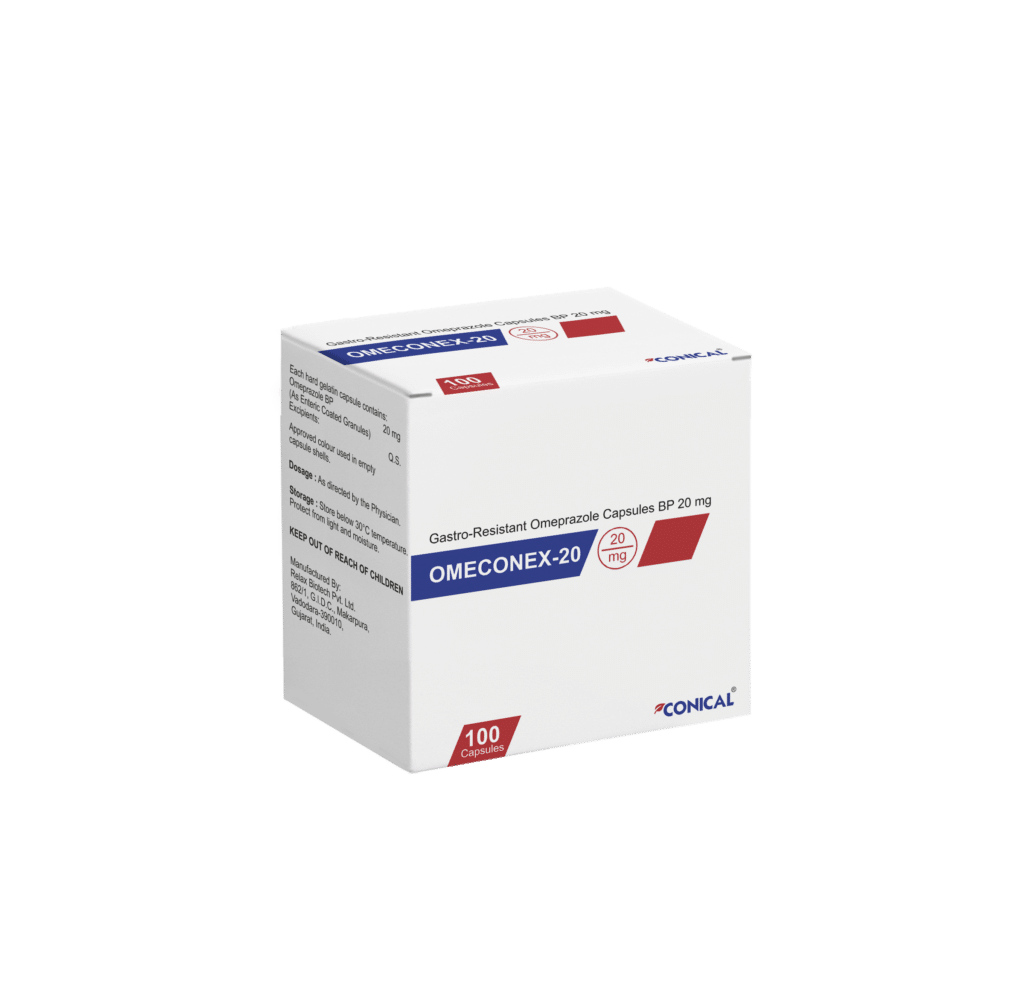
Gastro-resistant Omeprazole Capsules BP 20 mg use for Treatment of duodenal ulcers
Prevention of relapse of duodenal ulcers
Treatment of gastric ulcers
Prevention of relapse of gastric ulcers
In combination with appropriate antibiotics, Helicobacter pylori (H. pylori) eradication in peptic ulcer disease
Treatment of NSAID-associated gastric and duodenal ulcers
Prevention of NSAID-associated gastric and duodenal ulcers in patients at risk
Treatment of reflux oesophagitis
Long-term management of patients with healed reflux oesophagitis
Treatment of symptomatic gastro-oesophageal reflux disease
Treatment of Zollinger-Ellison syndrome
Paediatric use
Children over 1 year of age and ≥10 kg:
Treatment of reflux esophagitis
Symptomatic treatment of heartburn and acid regurgitation in gastro-oesophageal reflux disease
Children and adolescents over 4 years of age:
In combination with antibiotics in treatment of duodenal ulcer caused by H. pylori
The recommended dose in patients with an active duodenal ulcer is Omeprazole 20mg once daily.
Abdominal pain, constipation, diarrhoea, flatulence, nausea/vomiting, Fundic gland polyps (benign), Headache.
In the presence of any alarm symptom (e.g. significant unintentional weight loss, recurrent vomiting, dysphagia, haematemesis or melena) and when gastric ulcer is suspected or present, malignancy should be excluded, as treatment may alleviate symptoms and delay diagnosis.
Omeprazole, as all acid-blocking medicines, may reduce the absorption of vitamin B12 (cyanocobalamin) due to hypo- or achlorhydria. This should be considered in patients with reduced body stores or risk factors for reduced vitamin B12 absorption on long-term therapy.
Omeprazole is a CYP2C19 inhibitor. When starting or ending treatment with omeprazole, the potential for interactions with drugs metabolised through CYP2C19 should be considered.
Some children with chronic illnesses may require long-term treatment although it is not recommended.
Hypomagnesaemia: Severe hypomagnesaemia has been reported in patients treated with PPIs like omeprazole for at least three months, and in most cases for a year. In most affected patients, hypomagnesaemia improved after magnesium replacement and discontinuation of the PPI. For patients expected to be on prolonged treatment or who take PPIs with digoxin or drugs that may cause hypomagnesaemia (e.g., diuretics), health care professionals should consider measuring magnesium levels before starting PPI treatment and periodically during treatment.
Proton pump inhibitors, especially if used in high doses and over long durations (>1 year), may modestly increase the risk of hip, wrist and spine fracture, predominantly in the elderly or in presence of other recognised risk factors. Patients at risk of osteoporosis should receive care according to current clinical guidelines and they should have an adequate intake of vitamin D and calcium.
Treatment with proton pump inhibitors may lead to slightly increased risk of gastrointestinal infections such as Salmonella and Campylobacter.
As in all long-term treatments, especially when exceeding a treatment period of 1 year, patients should be kept under regular surveillance.
Proton pump inhibitors are associated with very infrequent cases of Subacute cutaneous lupus erythematosus (SCLE). If lesions occur, especially in sun-exposed areas of the skin, and if accompanied by arthralgia, the patient should seek medical help promptly and the health care professional should consider stopping Omeprazole Capsules.
Alu-Alu blister packs.
Omeconex-20 is available in an Alu-Alu blister of 10 capsules. Such 10 blister with package insert in a carton.
Contact us directly to receive full information on the product, the formulation, the science behind it, stability data, and more. Our Business Development Manager is a click away.
Conical Pharmaceuticals is a professionally managed and dynamic organization with decades of experience in the pharmaceutical field. With a desire of providing opportunities for a better life, we work very hard to bring quality drugs to our customers. We have instilled a level of trust and confidence amongst our clients by supplying the best quality products.